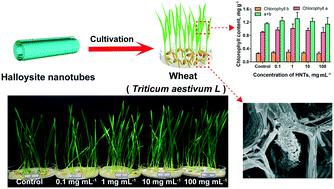当前位置:
X-MOL 学术
›
Environ. Sci.: Nano
›
论文详情
Our official English website, www.x-mol.net, welcomes your
feedback! (Note: you will need to create a separate account there.)
Phytotoxicity of halloysite nanotubes using wheat as a model: seed germination and growth
Environmental Science: Nano ( IF 5.8 ) Pub Date : 2021-08-18 , DOI: 10.1039/d1en00507c Linhong Chen 1 , Zizheng Guo 2 , Biyin Lao 1 , Chunlei Li 2 , Jianhua Zhu 2 , Rongmin Yu 2 , Mingxian Liu 1
Environmental Science: Nano ( IF 5.8 ) Pub Date : 2021-08-18 , DOI: 10.1039/d1en00507c Linhong Chen 1 , Zizheng Guo 2 , Biyin Lao 1 , Chunlei Li 2 , Jianhua Zhu 2 , Rongmin Yu 2 , Mingxian Liu 1
Affiliation

|
Due to their special structure and biocompatibility, halloysite nanotubes (HNTs) have critical applications in polymer composites, drug delivery, waste treatment, and cosmetics. With the advance of industrial products based on HNTs and agrochemical carriers, it is urgent to study their phytotoxicity. Here, the influence of HNTs on the germination and growth of plants using wheat seeds as a model was investigated. The biomass, chlorophyll content and oxidative damage index of the HNT treated wheat group were compared with the control. HNTs have no significant effect on the germination of wheat seeds. The biomass (root/shoot length, and fresh weight) of the wheat treated with different concentrations of HNTs increased at doses of 0.1, 1, and 10 mg mL−1, while it decreased significantly at high concentrations of HNTs (100 mg mL−1). The chlorophyll content and oxidative damage index (cell membrane permeability, H2O2 content, malondialdehyde content) increased with HNT concentration. A large accumulation of HNTs on the root sections was found in the high concentration HNT group, while no HNTs were observed in the xylem. Furthermore, HNTs can slightly decrease the viability of tobacco cells and promote the accumulation of biomass and secondary metabolites. This work demonstrated that HNTs at a certain concentration are safe to plants, while they are harmful at a high dose of 100 mg mL−1. The understanding of the phytotoxicity of HNTs is helpful for their applications in the environmental protection and agricultural field.
中文翻译:

以小麦为模型的埃洛石纳米管的植物毒性:种子萌发和生长
由于其特殊的结构和生物相容性,埃洛石纳米管 (HNT) 在聚合物复合材料、药物输送、废物处理和化妆品中具有重要的应用。随着基于HNTs和农化载体的工业产品的发展,迫切需要研究它们的植物毒性。在这里,以小麦种子为模型,研究了 HNTs 对植物萌发和生长的影响。将HNT处理小麦组的生物量、叶绿素含量和氧化损伤指数与对照进行比较。HNTs对小麦种子的萌发无显着影响。用不同浓度的 HNTs 处理的小麦的生物量(根/芽长和鲜重)在 0.1、1 和 10 mg mL -1 的剂量下增加,而在高浓度 HNT (100 mg mL -1 ) 下显着降低。叶绿素含量和氧化损伤指数(细胞膜通透性、H 2 O 2含量、丙二醛含量)随着HNT浓度的增加而增加。在高浓度 HNT 组中发现根部有大量 HNT 积累,而在木质部中未观察到 HNT。此外,HNTs 可以略微降低烟草细胞的活力并促进生物量和次生代谢物的积累。这项工作证明了一定浓度的 HNTs 对植物是安全的,而在 100 mg mL -1的高剂量下则是有害的. 了解HNTs的植物毒性有助于其在环境保护和农业领域的应用。
更新日期:2021-09-06
中文翻译:

以小麦为模型的埃洛石纳米管的植物毒性:种子萌发和生长
由于其特殊的结构和生物相容性,埃洛石纳米管 (HNT) 在聚合物复合材料、药物输送、废物处理和化妆品中具有重要的应用。随着基于HNTs和农化载体的工业产品的发展,迫切需要研究它们的植物毒性。在这里,以小麦种子为模型,研究了 HNTs 对植物萌发和生长的影响。将HNT处理小麦组的生物量、叶绿素含量和氧化损伤指数与对照进行比较。HNTs对小麦种子的萌发无显着影响。用不同浓度的 HNTs 处理的小麦的生物量(根/芽长和鲜重)在 0.1、1 和 10 mg mL -1 的剂量下增加,而在高浓度 HNT (100 mg mL -1 ) 下显着降低。叶绿素含量和氧化损伤指数(细胞膜通透性、H 2 O 2含量、丙二醛含量)随着HNT浓度的增加而增加。在高浓度 HNT 组中发现根部有大量 HNT 积累,而在木质部中未观察到 HNT。此外,HNTs 可以略微降低烟草细胞的活力并促进生物量和次生代谢物的积累。这项工作证明了一定浓度的 HNTs 对植物是安全的,而在 100 mg mL -1的高剂量下则是有害的. 了解HNTs的植物毒性有助于其在环境保护和农业领域的应用。










































 京公网安备 11010802027423号
京公网安备 11010802027423号